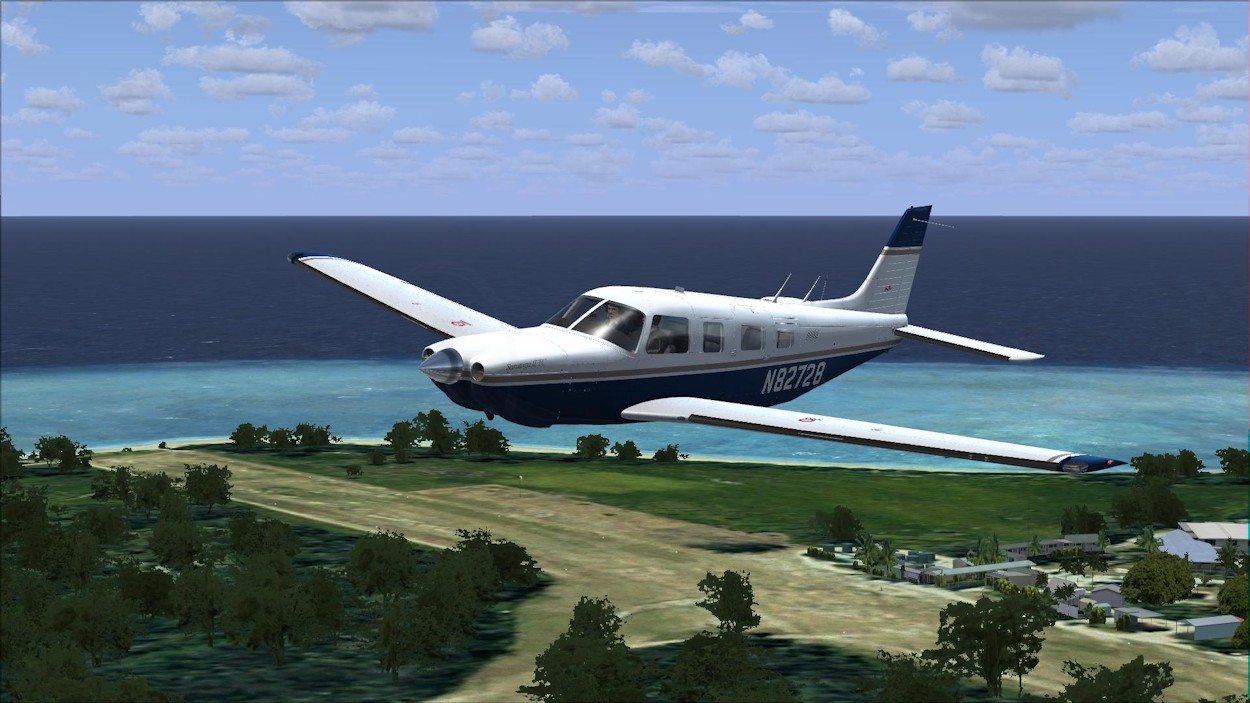Mutley's Hangar
A Haven For Flight Simulation Enthusiasts!
.jpg)
For FSX / Prepar3D Published by Alabeo
Reviewed by Andrew Godden
December 2014
Introduction
Founded in 1927, Piper Aircraft have had a long history in light
aircraft manufacturing. A prolific producer of a range of aircraft
models, the Piper name is synonymous with some of the most iconic
and popular aircraft models in the general aviation category. Models
such as the J-3 'Cub', PA-18 'Super Cub', PA-20 / PA-22 'Pacer' /
'Tri-Pacer', and the extensive PA-28 'Cherokee' range, all have a
prominent place in aviation history.
Alabeo continue to add to their offering of general aviation
aircraft with the Piper PA-32 'Saratoga II' TC. The 'Saratoga II' TC
was the last model variant in the broader PA-32 'Cherokee Six' range
and it is a beautiful complement to the Alabeo range. With its high
performance and good range characteristics, the 'Saratoga II' TC is
a brilliant aircraft for personal use or in an air taxi or freight
role.
History
The Piper PA-32 'Saratoga II' TC is a single engine, low wing,
passenger aircraft with a retractable tricycle landing gear. Powered
by a Lycoming TIO-540-AH1A, turbocharged, 6 cylinder, horizontally
opposed, fuel injected, 300 hp engine, the 'Saratoga II' TC is used
for private transportation, air taxi services, and freight and
utility flight operations.
Until 1972, when the Piper assembly line in Lock Haven, Pennsylvania
was destroyed in a flood, the PA-24 'Comanche' was Piper's luxury,
high performance, single engine aircraft. Rather than re-establish
'Comanche' production, Piper began modifying its heavy lifting,
single engine, PA-32 'Cherokee Six', by adding retractable landing
gear and designating the type as the PA-32R.
The PA-32R design began life as the Piper 'Lance', using the
'Hershey Bar' wing design from the 'Cherokee Six'. Common with the
'Cherokee Six' line, it also features a baggage compartment in the
nose between the cockpit and the engine compartment, as well as a
large double door in the back for easy loading of passengers and
cargo. Having its first flight in August 1974, the PA-32R was
introduced in 1975. After a redesign to a tapered wing, the type was
redesignated the 'Saratoga'. Production culminated with the
'Saratoga II' TC variant in 2009 after a production run of some
2,721 aircraft.
Availability and Installation
The Alabeo Piper PA-32 'Saratoga II' TC is currently available
direct from Alabeo and Alabeo resellers as a 'download only' product
(some resellers also offer a master back-up CD / DVD service for a
minor additional cost). It is priced at US$29.95, or the equivalent
on currency cross rates. The download file size is 338MB and it
requires 887MB of HDD space for installation. An ‘activation key' is
issued on purchase and is used during installation and the
installation process is intuitive and seamless.
Model Features
The model features listed by Alabeo for the Piper PA-32 'Saratoga
II' TC are typical of models in the Alabeo range and include:
• high quality 3D model;
• high definition textures;
• Alabeo Garmin GNS 530 and GNS 430
GPS units;
• Flight1 GTN 750 integration;
• Reality XP GNS 530 integration;
• custom 'Saratoga II' TC sounds;
• gauges reflections and windows
scratches;
• blades shines and volumetric side
view prop effect; and
• realistic behaviour.
Visual Appearance
General. Piper
aircraft designs are practical and functional, reflecting the role
the aircraft are designed for. The 'Saratoga II' TC is reflective of
this design concept and its looks are true to its role and
capabilities. Alabeo have specifically modelled an early production
model of the PA-32R-301T 'Saratoga II' TC variant and, as regularly
demonstrated by Alabeo, their modelling has accurately captured the
essential, design of the 'Saratoga II' TC.
Exterior. The
Piper PA-32 'Saratoga II' TC is distinguishable from the broader
PA-32 'Cherokee Six' range by its engine cowl, with smaller, round
air inlets, and retractable landing gear. Alabeo have established
themselves with a reputation for quality, attention to detail, and
sheer consistency in their development of aircraft add-ons, and the
modelling of the 'Saratoga II' TC displays all of these attributes
with the high quality 3D model and high definition textures. A
comparative review of photographs of real world aircraft to Alabeo's
rendition reveal the exterior shape and dimensions to be very
accurate and a true representation of the real world aircraft. Any
noted variations were minor and are considered to be related to real
world production variations or a degree of artistic licence on the
part of the developer.

General |

Top Down |

The Front End |

Wing & Passenger Door |

The Cockpit |
|
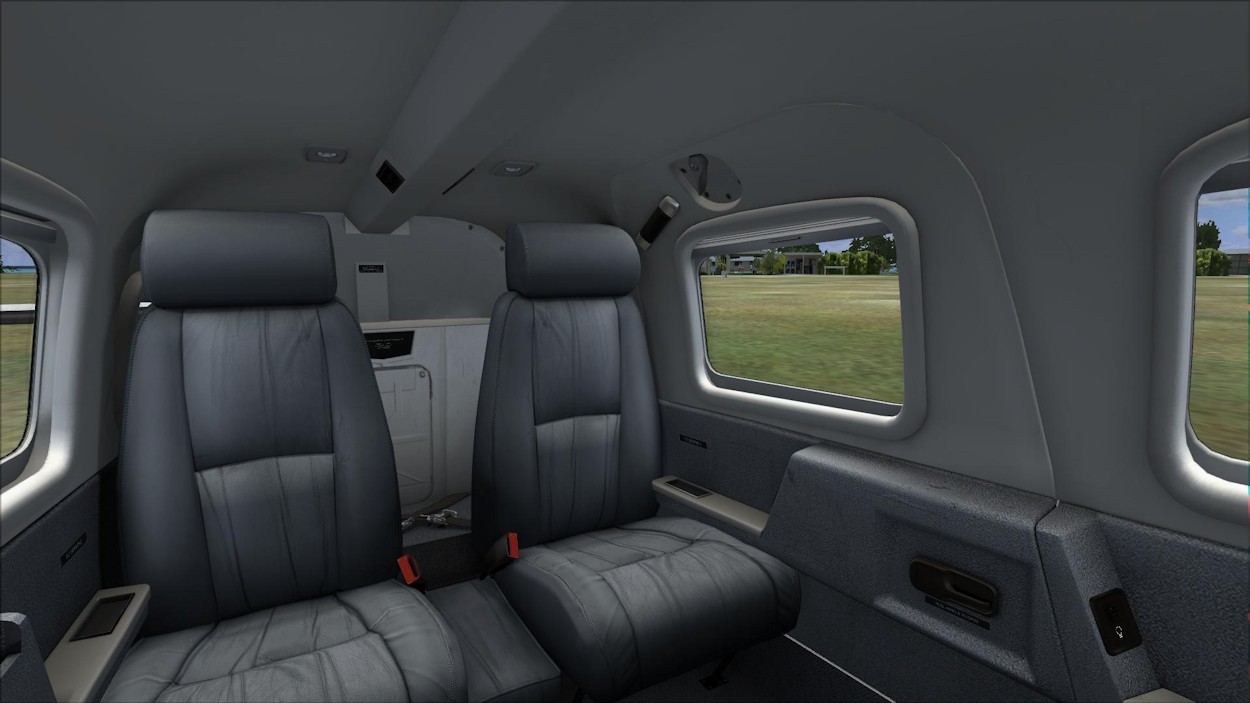
The Cabin |
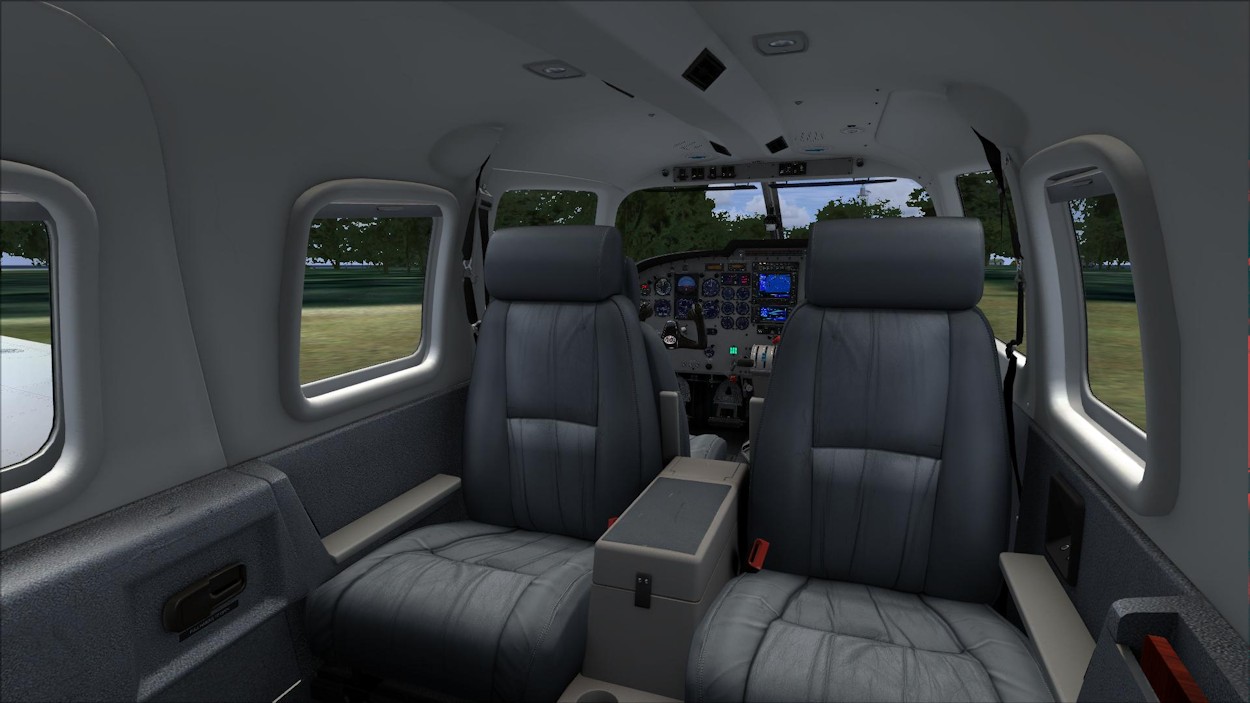
Comfort & Pleasure |

Instrument Panel |
|
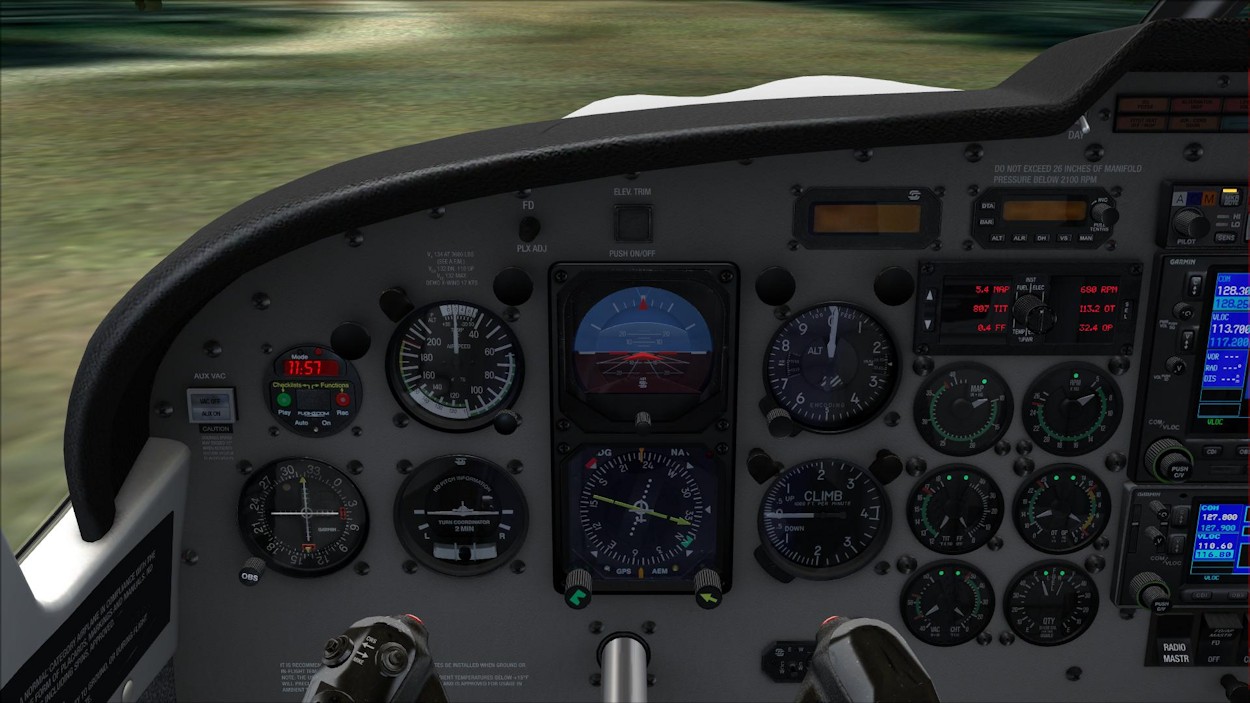
Pilot Position |
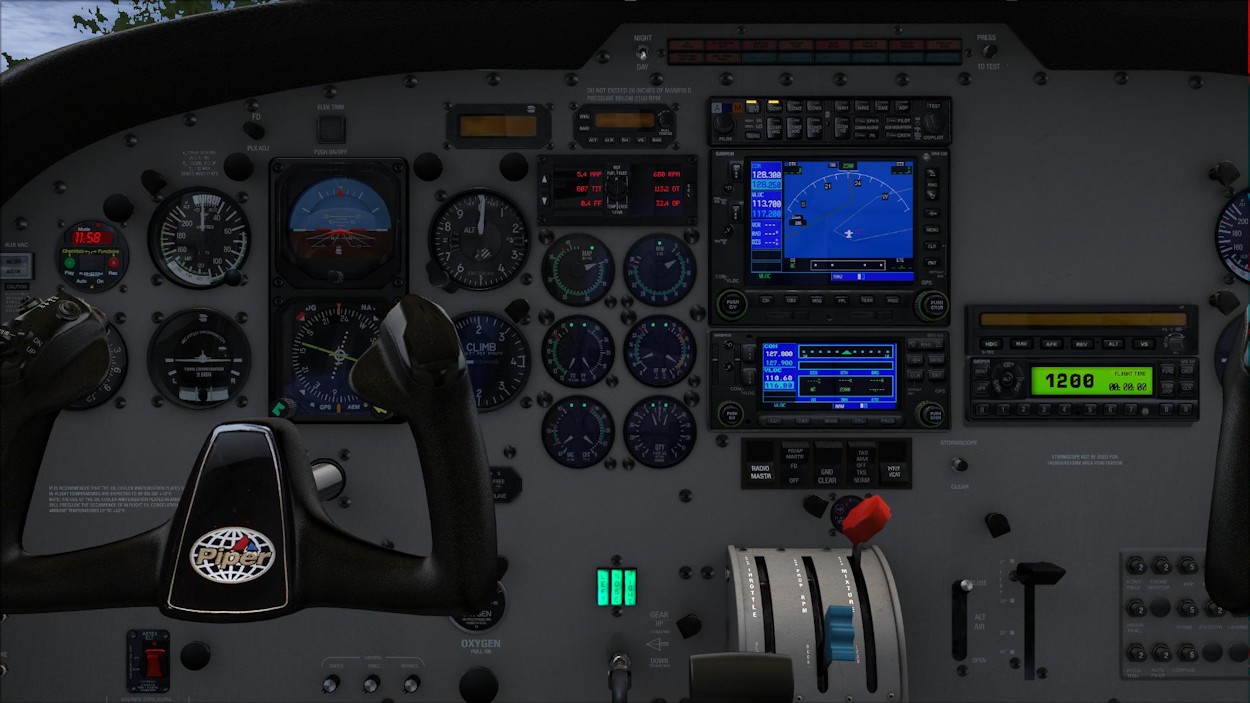
Engine Instruments & GPS Units |

Throttle Quadrant |

Overhead Switches |

PR-FHM |

PR-CLP |

N5491 |

N84969 |
The animations of the primary and secondary control surfaces and other moving elements on Alabeo's Piper PA-32 'Saratoga II' TC are all modelled faithfully and include:
• primary control surfaces – ailerons, stabilator, and rudder;
• secondary control surfaces – flaps;
• others – retractable gear, rolling wheels, antiservo tab, cockpit door open / close, cabin door open / close, forward baggage compartment door
open / close, pilot vent window open / close, cockpit window visors, and cabin window shades; and
• various static ground elements.

Parked Up |

Shades Down |

Cockpit Lighting |
|

Cabin Lighting 1 |

Cabin Lighting 2 |
General Characteristics and Performance Specifications
The general characteristics and performance specifications for the Piper PA-32 'Saratoga II' TC are provided in the table. This is based on data from the official Piper PA-32 'Saratoga II' TC Pilot Operating Handbook, data provided by Alabeo, and general research sources. Some of this data varies between sources and also may be an approximation due to variances in data and the specific aircraft modelled by Alabeo.

Flight Performance
A specific Test Flight was conducted from Lady Elliot Island (YLTT) to Essendon (YMEN) to test the flight performance of Alabeo's Piper PA-32 'Saratoga II' TC. The flight was conducted in clear weather with a full fuel load and the aircraft at maximum take-off weight (MTOW). A cruise altitude of 6,500 ft was adopted and the route distance was approximately 910 nm. The route was particularly chosen to provide a basis upon which to test the range characteristics of the 'Saratoga II' TC. Like most aircraft of this type, adjustments must be made to fuel / pax loading to remain within the MTOW limitations.
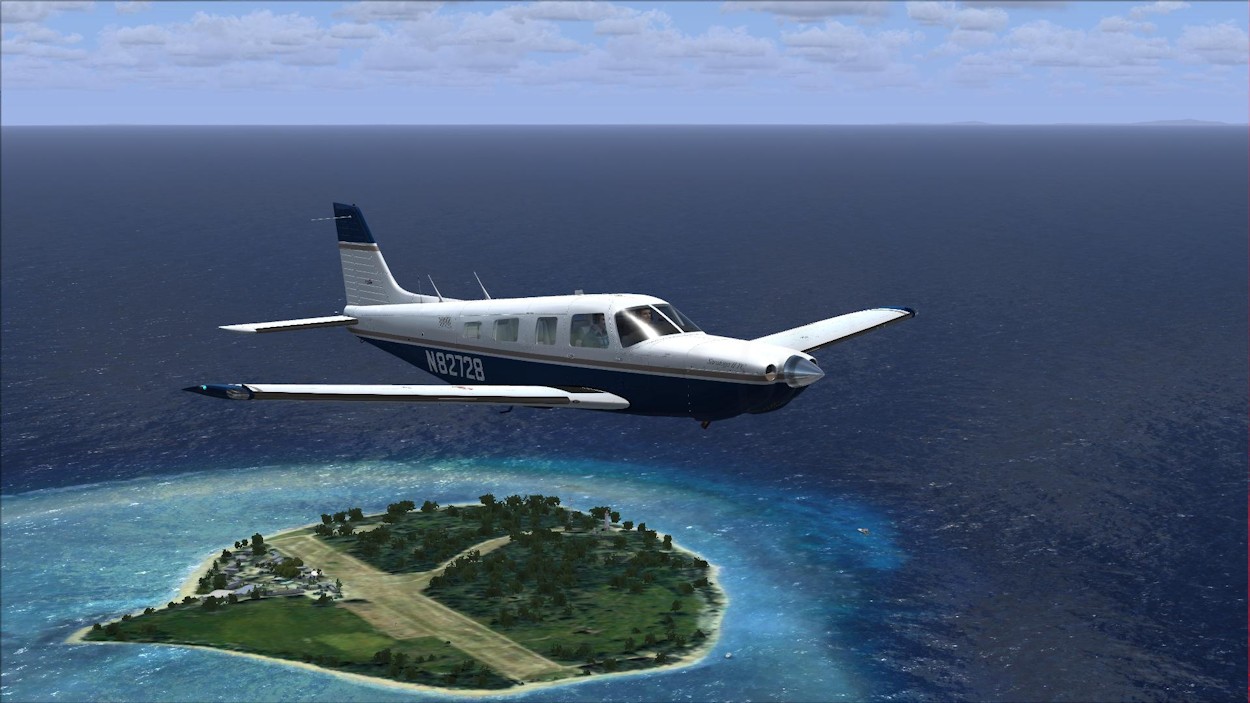
In Flight |
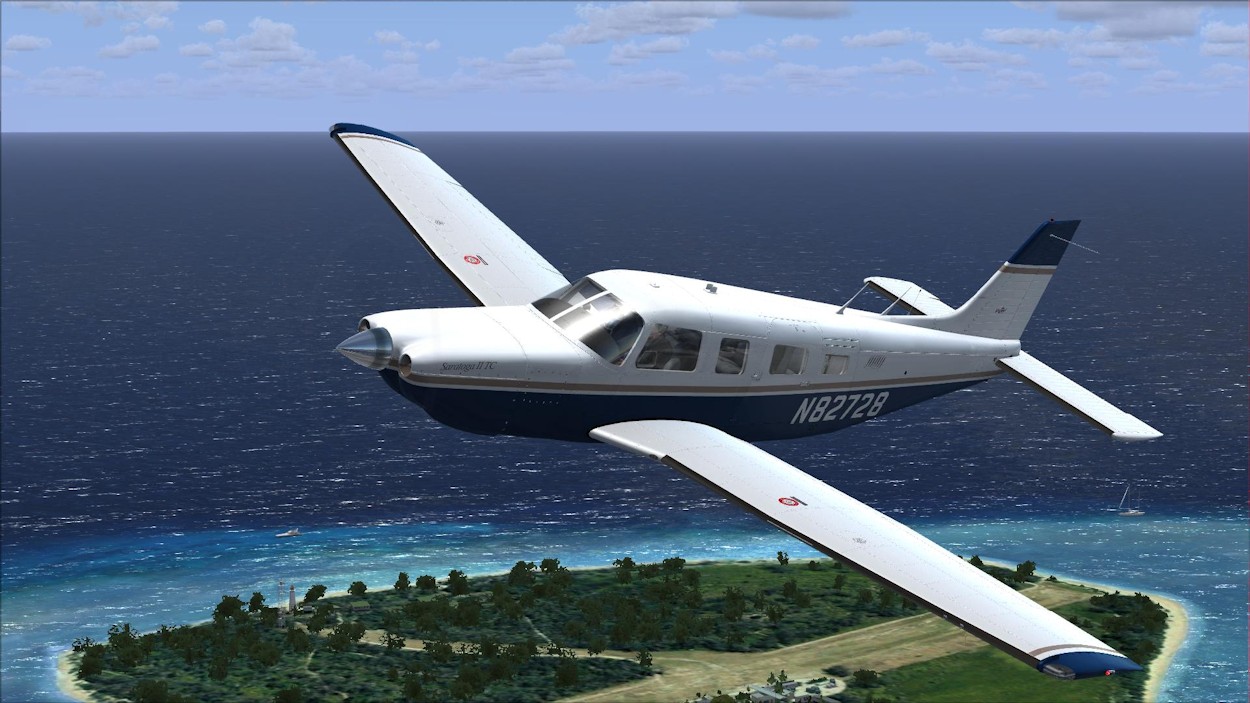
Easy Cruising |
During cruise, a 55% power setting was established for long range cruise, with a manifold pressure setting of 25.0 in Hg and an rpm setting of 2200 rpm. This cruise setting produced an average speed of approximately 136 KTAS (125 KIAS), a fuel flow rate of approximately 10.5 gph, and an endurance reasonably consistent with the range characteristics of the aircraft. This represented a variance in fuel flow performance compared to the Performance Tables provided by Alabeo. The Performance Tables indicate the performance settings, as used in the Test Flight, should have produced a fuel flow rate of approximately 12.5 gph. The Test Flight confirms the modelling of the aircraft for speed and range performance to be reasonably accurate. Whilst the detected variance in the fuel flow rate had a significant, albeit positive, impact on the range performance of the aircraft, it does not detract from the flying characteristics of the aircraft. It is estimated the variance in the fuel flow rate, over the duration of the Test Flight, resulted in fuel consumption being approximately 15 gals less than expected.

Underbelly |
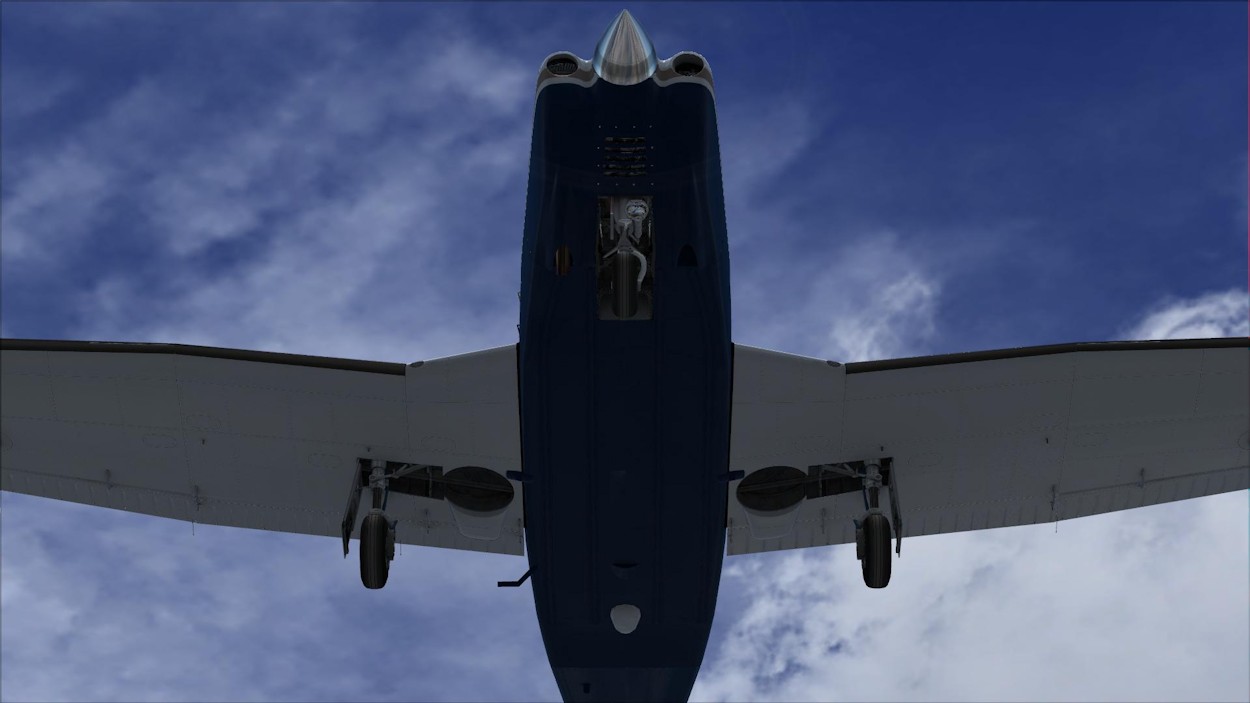
Landing Gear |
In testing the accuracy of the instruments, based on the measured Test Flight, the speed indications on the airspeed indicator, were consistent with the averages measured. Additionally, when establishing a set rate of climb on the vertical speed indicator, the respective gain in altitude on the altimeter was achieved within the measured minute, and a standard rate turn was achieved within the measured two minute period using the turn coordinator.
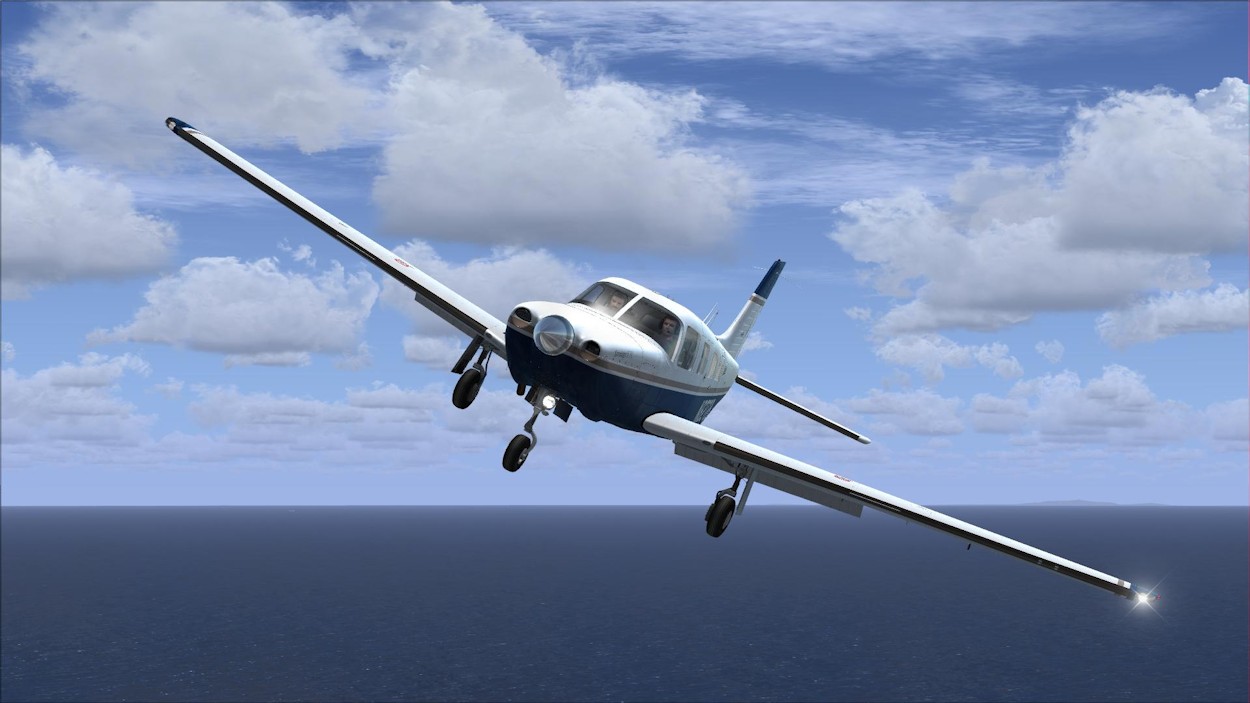
Turning for Finals |
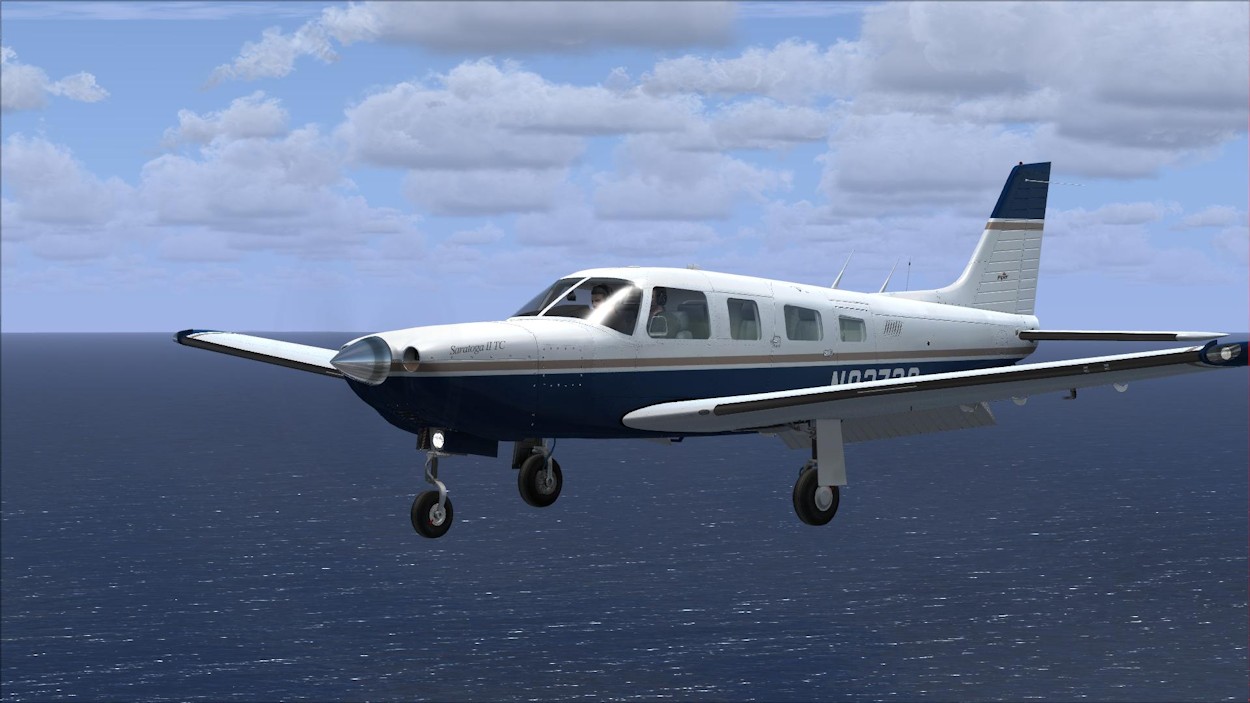
Final Approach |
Documentation
There are seven manuals / documents provided in Adobe Acrobat format (.pdf) for the Piper PA-32 'Saratoga II' TC:
• Alabeo GNS 530 Users Guide - this two page document details the operating of the Garmin GNS 530 GPS unit;
• Alabeo GNS 430 Users Guide - this three page document details the operating of the Garmin GNS 430 GPS unit;
• Alabeo Autopilot and AVSS - this two page document details the operating of the S-TEC System Fifty Five X autopilot system, and the Altitude
and Vertical Speed Selector;
• Normal Procedures - this 13 page manual details the procedures for the normal operation of the aircraft;
• Emergency Procedures – this 10 page manual details the emergency procedures for the aircraft;
• Performance Tables – this five page document details the performance tables and specifications for the aircraft; and
• References - this three page document details the airspeed limitations for the aircraft.
Additional documents provide information for P3D users and information on the integration of the Flight1 GTN 750 GPS unit and the Reality XP GNS 530 GPS unit.
Value for Money
On a value for money assessment, the Alabeo Piper PA-32 'Saratoga II' TC is considered excellent.
Simulator Performance
The aircraft model performed excellently within the existing settings I have in FSX. I have most of my settings set very high and there was no need to make any adjustments. There was no discernible frame rate impact directly attributable to the Alabeo Piper PA-32 'Saratoga II' TC and FSX continued to perform smoothly and as it would with any default aircraft.
Technical Requirements
This version of the Alabeo Piper PA-32 'Saratoga II' TC is for FSX / P3D only. Other specified technical requirements are as follows:
• Windows XP (with SP3 installed), Windows Vista, or Windows 7 (32 or 64bit);
• Microsoft Flight Simulator FSX with SP1 and SP2 (or Acceleration Pack) or Lockheed Martin Prepar3d Flight Simulator v1.4 or v2.0 installed; and
• Pentium V, 3GHz or similar, 2GB RAM, 512MB graphics card, and 887MB available HDD space.
Review Computer Specifications
The specifications of the computer on which the review was conducted are as follows:
• Intel i7 990X Extreme 3.46GHz;
• NVidia GTX580, 1536MB graphics;
• 12GB Kingston DDR3 2000MHz;
• Windows 7, (64bit);
• Microsoft Flight Simulator FSX Acceleration; and
• additional major add-ons include: Active Sky Next, REX Essential Plus Overdrive; Ultimate Traffic 2; Orbx FTX Global BASE;
Orbx FTX Global VECTOR; Orbx FTX Global openLC EU; Orbx FTX region series; and Orbx FTX airport series.
Conclusion
Alabeo have delivered again, doing an excellent job with the Piper PA-32 'Saratoga II' TC and it is a fantastic complement to the other general aviation aircraft in their repertoire. The 'Saratoga II' TC displays the hallmark Alabeo traits of detail and accuracy and provides an excellent balance of quality and detail at an excellent price. With excellent cruise speed and range characteristics, the 'Saratoga II' TC is a wonderful aircraft for touring and one you will enjoy flying.
Verdict
Displaying the usual high quality and attention to detail, the Piper PA-32 'Saratoga II' TC is another fine product from Alabeo which represents excellent overall value for money.
Pros:
High quality textures and attention to detail.
Realistic modelling and performance.
Very good documentation.
Excellent value for money.
Cons:
Minor issue with the elapsed flight time function on the digital transponder.
Minor variation in fuel flow compared to flight performance data.
Low texture quality in some areas of the cabin.
| Scores: |
 | |
| ● External Model: | 10/10 | |
| ● Internal Model: | 9.0/10 | |
| ● Sounds: | 10/10 | |
| ● Flight Characteristics (does it fly by the numbers): | 9.0/10 | |
| ● Flight Dynamics (does it feel like what it looks like): | 9.5/10 | |
| ● Documentation: | 9.0/10 | |
| ● Value for Money: | 10/10 |
The Alabeo Piper PA-32 'Saratoga II' TC is awarded an overall Mutley’s Hangar score of 9.5/10, with an "Outstanding" and a Mutley's Hangar Gold Award.. |
